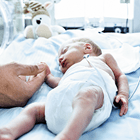Printed from acutecaretesting.org
June 2002
Neonatal-pediatric application of transcutaneous pO2/pCO2 monitoring
In my experience, the transcutaneous pO2/pCO2 monitor is valuable in a variety of clinical situations that demand close observation by the healthcare practitioner of the ventilatory needs of the patient. There are at least three areas of application for transcutaneous monitoring in the neonatal-pediatric population:
- High-Frequency Oscillatory Ventilation (HFOV) initiation
- Transitioning modes of ventilation
- Inter-facility transport
A prime example of a clinical situation that demands close observation by the healthcare practitioner is an infant that requires HFOV. The ability to monitor tcpCO2 while initiating HFOV is crucial. Adjusting the amplitude or Hz setting during the initiation of HFOV by monitoring tcpCO2 is essential in decreasing the incidence of acute lung injury and potential neurological injury caused by lung overdistension.
Manipulating the HFOV settings by utilizing a transcutaneous monitor allows the practitioner to maintain the pCO2 levels of a patient within a designated range in an efficient manner without waiting for a blood gas result [1]. Implementing transcutaneous monitoring as a standard of practice during the initiation of HFOV for both neonatal and pediatric patients promotes a strategy that protects the lung from the problems associated with barotrauma.
Transitioning a patient between modes of ventilation is another example where the transcutaneous monitor can be beneficial. Infants and children that initially require HFOV will generally reach a point in their hospital course where they will need to transition to some form of conventional ventilation. The ability to fine-tune or make small changes on the conventional ventilator such as rate, peak pressure, or tidal volume during the transition phase by monitoring tcpCO2 allows the practitioner to increase the likelihood that the patient will tolerate the change successfully and avoid the problems associated with hyperventilation or hypoventilation.
Another area where the trans-cutaneous monitor has been beneficial is inter-facility transport. Infants with the diagnosis of Persistent Pulmonary Hypertension of the Newborn (PPHN) on Inhaled Nitric Oxide (INO) therapy that require inter-facility transport can be one of the most challenging and difficult patients to transport.
The ability to monitor tcpO2/tcpCO2 levels in critically ill infants during transport allows the transport team to carefully observe the ventilatory status of the infant and intervene appropriately based upon the transcutaneous pO2/pCO2 values. In my experience, implementing transcutaneous pO2/pCO2 as a standard of practice during inter-facility transport of critically ill newborns promotes safety and efficiency in transport.
References+ View more
- Okumura, Akihisa. Hypocarbia in preterm infants with periventricular leukomalacia: The relationship between hypocarbia and mechanical ventilation. Pediatrics 2001; 107: 469-75.
- Kacmarek, Robert. Mechanical ventilation: Ventilatory techniques, pharmacology, and patient management strategies. Respiratory Care 1996; 41,5: 466-72.
- Radiometer Medical A/S. Applying the Continuous Baby Picture™. Transcutaneous pO2/pCO2 Monitoring in Neonatology, Copenhagen: Radiometer Medical A/S, 1993.
References
- Okumura, Akihisa. Hypocarbia in preterm infants with periventricular leukomalacia: The relationship between hypocarbia and mechanical ventilation. Pediatrics 2001; 107: 469-75.
- Kacmarek, Robert. Mechanical ventilation: Ventilatory techniques, pharmacology, and patient management strategies. Respiratory Care 1996; 41,5: 466-72.
- Radiometer Medical A/S. Applying the Continuous Baby Picture™. Transcutaneous pO2/pCO2 Monitoring in Neonatology, Copenhagen: Radiometer Medical A/S, 1993.
May contain information that is not supported by performance and intended use claims of Radiometer's products. See also Legal info.
Acute care testing handbook
Get the acute care testing handbook
Your practical guide to critical parameters in acute care testing.
Download nowRelated webinar
Combining blood gas invasive and non-invasive monitoring for the best care of our neonates
Webinar presented by Dr. Kaare E. Lundstrøm, Pediatric emergency and intensive care unit, Rigshospitalet, Denmark Watch the webinarRelated webinar
TC monitoring in NICU - the value of tcpO2
Presented by Daniele De Luca (MD,PhD), Associate Professor of Neonatology, Chef de Service - Medical Director, Pediatrie et Reanimation Neonatale - Pediatrics and Neonatal Critical Care, GH Paris Sud - South Paris University Hospitals Watch the webinarRelated webinar
Cord blood gas analysis in obstetrical practice
Webinar presented by Jan Stener Jørgensen, MD PhD, Head of Obstetrics and Professor of Clinical Obstetrics, University of Southern Denmark Watch the webinarScientific webinars
Check out the list of webinars
Radiometer and acutecaretesting.org present free educational webinars on topics surrounding acute care testing presented by international experts.
Go to webinars










